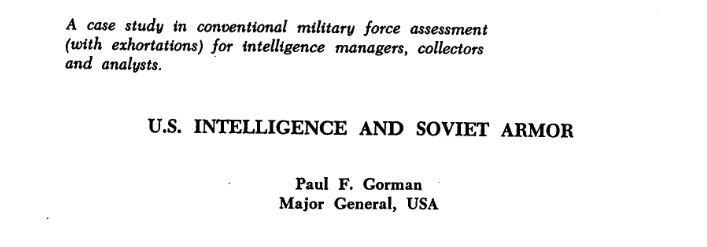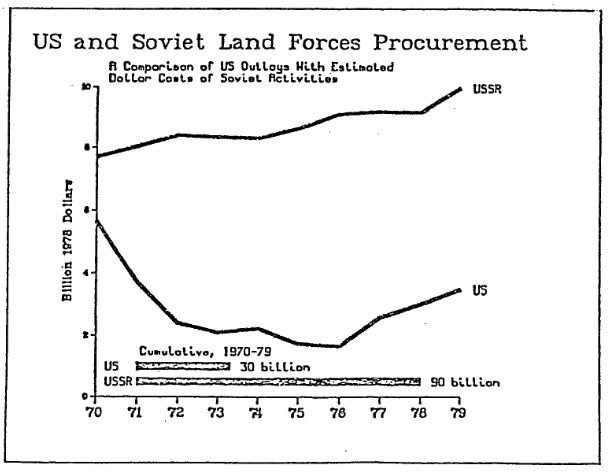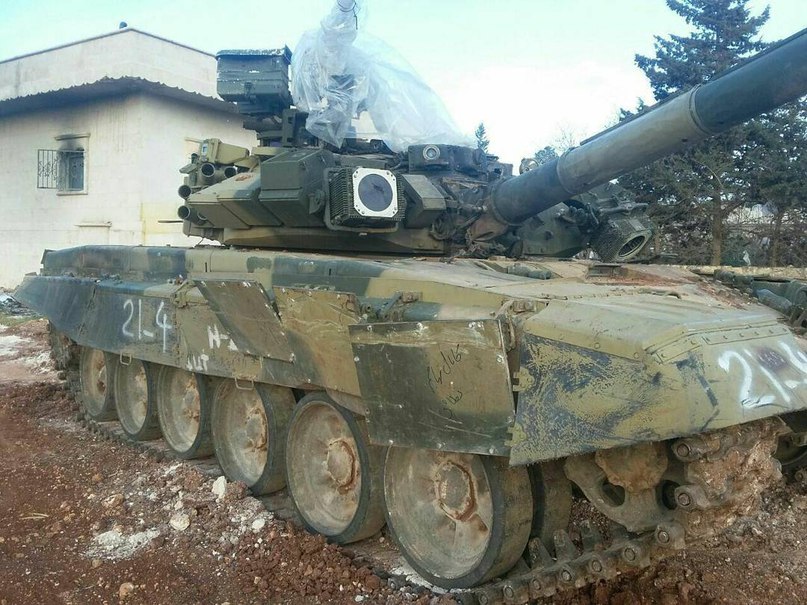I remember reading all the reports from all the Newsweek and other publications and plus the stuff that my Dad brought home from the U.S Army and they had talked about the sheer numbers of Soviet Tanks and that they would come through the "Fulda_Gap" like cockroaches in a New York City apartment. I remember the graphs and reports about the sheer numbers of tanks that were available to GSFG for the conquest of Western Europe. I recall reading a document that was unclassified by the Kremlin after the Soviet Union Fell, that the KGB calculated that any chance the Soviets had to conquer Western Europe was pretty much gone by 1983 due to the new spending from the Reagan Military buildup and the infusion of training, parts and equipment that the U.S Military was getting as well as NATO was getting.
In 1980, the U.S. Army had a terrifying vision: an armada of Soviet tanks sweeping across Western Europe, all the way to the English Channel. And the U.S. Army feared it had no weapons that could stop this vision from becoming a reality.
“In the arms likely to dominate the outcome of a future battle for Central Europe — armored fighting vehicles and counterweapons — the U.S. Army, then, probably will remain qualitatively and quantitatively inferior,” wrote U.S. Army Major General Paul Gorman in a secret 1980 study that wasn’t declassified until 2014.

The situation sounds eerily familiar to today, where critics question whether Russia’s next-generation T-14 Armata tank is superior to Western models. Or, whether U.S. and British anti-tank weapons will be effective against a Russian invasion of Ukraine that will rely on tanks for maneuver and firepower.
Throughout the Cold War, the United States accepted that its forces in Europe would be outnumbered by a massive Soviet war machine that by 1980 comprised 50,000 tanks — or five times the American tank arsenal. But U.S. leaders had always comforted themselves with the thought that Soviet numbers could be offset by superior American technology, training and tactics.

But by the end of the 1970s, when American military power had ebbed to its post-Vietnam low, Pentagon planners worried that the Soviet Union had achieved superiority in tank quality as well as quantity. In particular, they warned that the new T-72 outclassed the M60A1 and M60A3 — essentially upgrades of the 1950s M48 Patton — that were the backbone of the American tank arsenal at the time.
Even the first M1 Abrams tanks entering service — armed with the 105-millimeter cannon instead of the later 120-millimeter cannon — would have difficulty knocking out the more heavily armed T-72.
“The U.S. Army rates the best current Soviet tank clearly superior to its main battle tank,” the Army report warned.

It assessed the T-72 as superior to the M60A1 by virtue of superior firepower and armor protection. The T-72 was also believed to have numerous advanced features that the M60 lacked, including an “automatic electronic rangefinder, possibly laser rangefinder,” an autoloader to increase rate of fire, a snorkel to cross rivers without needing bridging equipment, and an anti-radiation liner to protect the crew from nuclear weapons. The Army did at least credit the M60 with carrying 60 rounds of main gun ammunition versus 40 for the T-72.
M60 in a German Village during "REFORGER" in 1982Nor could salvation be found in the anti-tank guided missiles that had begun entering service in the 1970s. Tests and mathematical modeling by the Army’s Ballistic Research Laboratory estimated that U.S. TOW and Dragon anti-tank missiles and the M-735 tungsten core round for the 105-millimeter cannon had a probability of kill (pK) as high as 77 percent against the front armor of a Soviet T-62 tank. But against the T-72, that probability dropped to as low as 22 percent, with even the upcoming M-774 depleted uranium round only having a 50 percent chance to kill a T-72 according to the worst-case models.

That meant defense against a tank-centric Soviet invasion of Europe would be difficult until the 120-millimeter-armed M1 arrived in the mid-1980s.
“Whether one uses informed U.S. or Soviet calculations, the conclusion is that NATO can expect, through 1984, no advantage over the Soviets in quality of armor or antiarmor weapons, and only a modest redressing of its present quantitative disadvantage,” the study concluded.

But were these dire predictions justified? It’s hard to be sure. While U.S.- and Soviet-made armor did clash in the 1973 and 1982 Arab-Israeli wars, a climactic — and perhaps apocalyptic — battle between American and Soviet armies never happened. Still, the much-vaunted T-72 seemed more of a paper tiger in the 1982 Lebanon War, when Israeli Merkava tanks armed with 105-millimeter guns disposed of them. And pitted against the Abrams in the First Gulf War, Iraqi T-72s seemed almost pitiful.
While Moscow could try to blame these debacles on the incompetency of their allies, or the fact that they were using inferior export models of Soviet equipment, that 1970s generation of T-72 tanks and MiG-23 fighters was not impressive in action. Even Syrian-manned T-90s may have been knocked out by U.S-made TOW anti-tank missiles supplied to Syrian rebels in 2016 and 2017.

As the Nazis with their Tiger and Panther tanks could attest, merely having the most powerful tanks doesn’t guarantee victory. Well-trained crews, flexible command and control, reliable logistics, and plentiful airpower are more important than the thickness of a tank’s armor.
In the end, that 1980 U.S. Army study seems less about the superiority of Soviet tanks, and more about the fact that U.S. tank design atrophied between 1945 and 1980. With defense dollars and priorities focused on nuclear weapons and chasing guerrillas through Asian jungles, tanks had become far from the most vital component of U.S. military power. It wasn’t until the M1 Abrams arrived in the 1980s that the U.S. could claim to have a cutting-edge tank, and arguably the best in the world. On the other hand, many Soviet tanks tended to resemble the 1950s T-55 (itself descended from the World War II T-34), which suggests that changes in tank design tend to be evolutionary rather than revolutionary.

Nonetheless, compare a Little Willie tank from World War I to an Abrams, and it’s obvious that tanks do change as technology progresses. Tanks inevitably change just as warfare does, and just as inevitable are the cries that the enemy’s tanks are superior. Fears that the Soviets had better tanks in 1980 are echoed today by warnings that the M1 and other Western tanks are inferior to the T-14 Armata, with its active protection system to shoot down anti-tank rockets, sophisticated sensors and data networking, and powerful 125-mm cannon housed in an unmanned turret while the crew remains safely cocooned inside the thickly armored hull.
For its part, the U.S. and other nations are developing new designs as well. The U.S. Army, for example, wants a family of armored vehicles that will include robot tanks. France and Germany are exploring a joint European tank that might feature a 140-millimeter cannon.
No doubt there will be Russian experts that will claim their tanks are inferior with these platforms enter service — and demand that the Kremlin fund the design of newer, better models (regardless of whether the T-14 has even entered production yet).


Historically Russian hardware has always come out on the short end when it has been lifted against western tech. That is not guaranteed to be the case forever. Hardware matters. So does training and tactics. And finally as Stalin observed quantity has a quality all its own. In the pending possible festivities Russia will have one marked advantage.....home field. And it's an important one. If the Moron In Chief stumbles us into a shooting war with Russia it will probably be decided by whatever forces are present at the beginning and be over before any meaningful build up or resupply can happen. It !at also very easily do very from conventional not nuclear....and then ALL bets are off. The reality is that without nuclear weapons it is very hard to make an argument that they are a first class country/military. Operating close to home negates much of that handicap.
ReplyDeleteHey Daniel;
DeleteTraining can make all the difference and the past few years, the divisiveness I have seen makes me wonder if the U.S. Military is capable anymore. I would love to have the training that we had in the late 80's with the gear we had today.
The question in Ukraine is will the Russions still be tracked for their objective point via the follow on motorized rifle regiment. Remember all those paper and template battle exercises for Fulda?
ReplyDeleteHey Jim;
DeleteTank transporters are a big deal and I remember all those template battle exercises for Fulda and the Soviet attack.
As I recall the auto loader on the T-72 was more trouble than it was worth and the Soviets still included a large hammer to help get the transmission in and out of gear.
ReplyDeleteMuch like the old T-34, the Soviets made lots of tanks but not many spare parts or recovery vehicles. A broken down tank from road wear was a dead tank.
Hey Gerry;
DeleteYep the autoloader was problematic, it cut a crewmember for maintenance needs and it didn't function as well as a person would. We ain't so good in the spare parts anymore either. Spare parts cost money and with the budget being tight, parts will take a back seat to other priorities like careers, unlike before sequestration when the budget was flush.
I can remember when the first Soviet tank with explosive reactive armor were seen in the 80's. The end of NATO was nigh!
ReplyDeleteHey Gus;
DeleteYeap, Pepperage Farms remembers, LOL
I remember when I was a medical student around 1980-81. During the summers I worked as a programmer back in the days of mainframes at the end of the punched card era. I often worked at night, so I could get computer time -- you had to submit your cards to the operator who would run the program and give you the output. There was another guy at the computer center who was doing something similar. He was getting his PhD in history.
ReplyDeleteWe were talking about politics one day and he told me that we would either be in WWIII or the Soviet Union would collapse by 1989. I asked him why. he said that the Soviets could not match our technology, and that technology was going to radically change the kill ratio of our weaponry. Right now, he said, the numerical superiority of the Soviets assured them of at least early victory if they crossed Fulda Gap, though keeping territory would be another matter.
The way things were going, he said, there would be parity at the end of the decade. As the Soviets dropped further and further behind technologically, their numerical superiority would mean less and less. He said that at that time the Soviet Union would have to make a decision. Either they would have to start the war, or they would have to undergo regime change.
I forgot all about it until the Rejavik conference, the "stars wars" thing with Reagan, and the collapse of the USSR. I was flabbergasted. And, then a couple of years later, came the battle of Medina Ridge.
I've always wondered what happened to that guy.